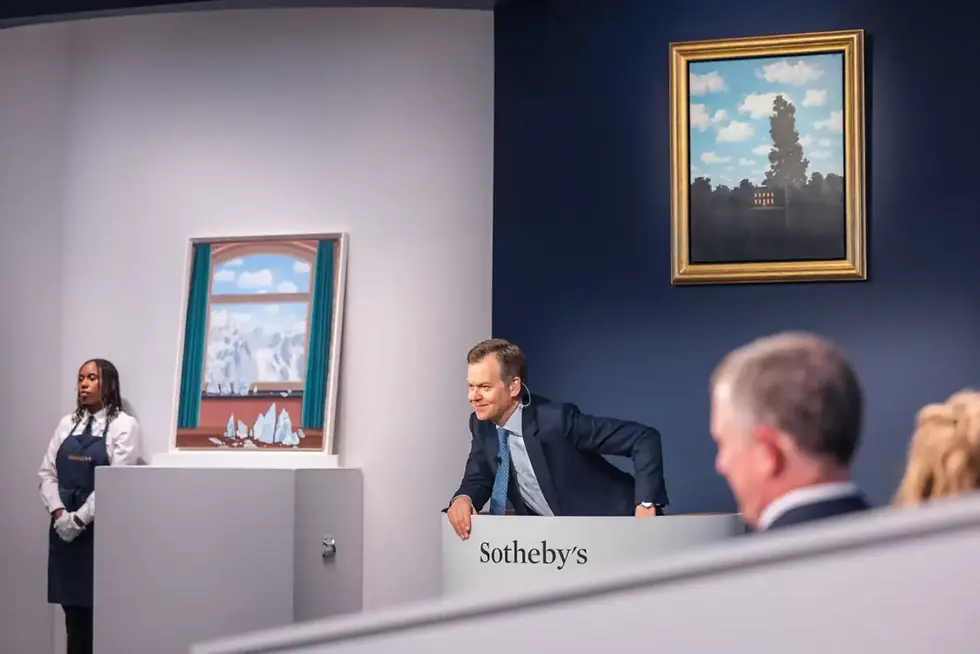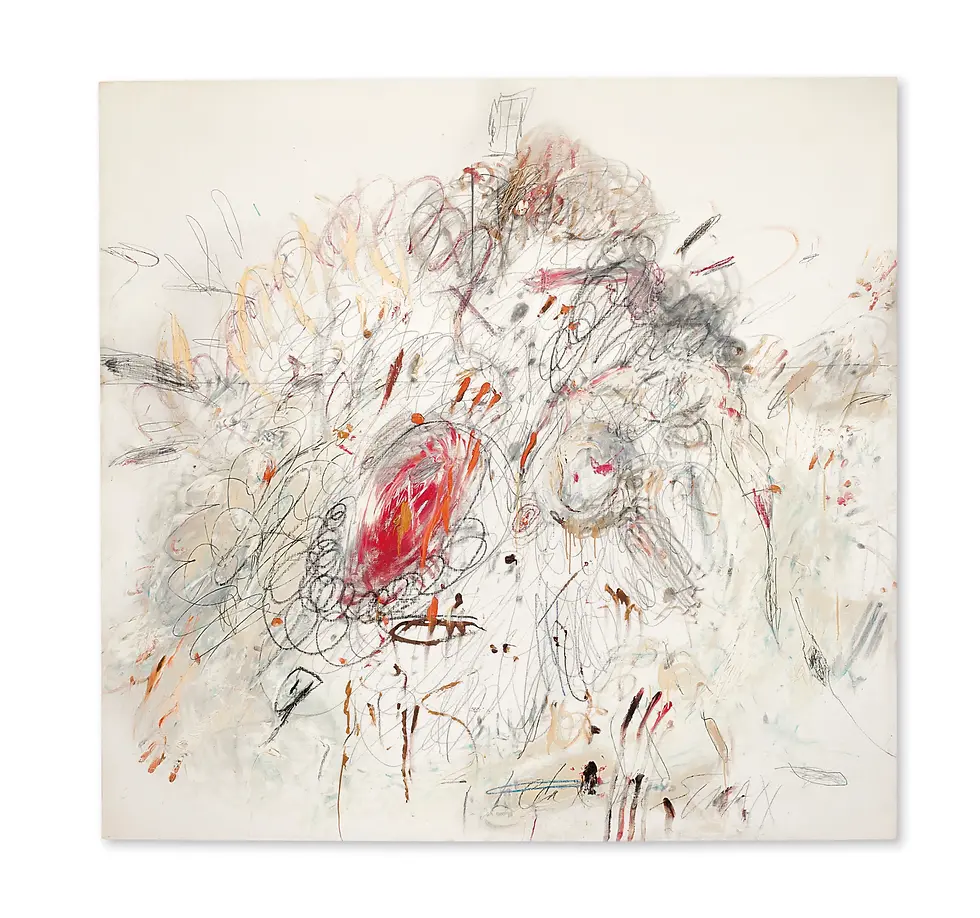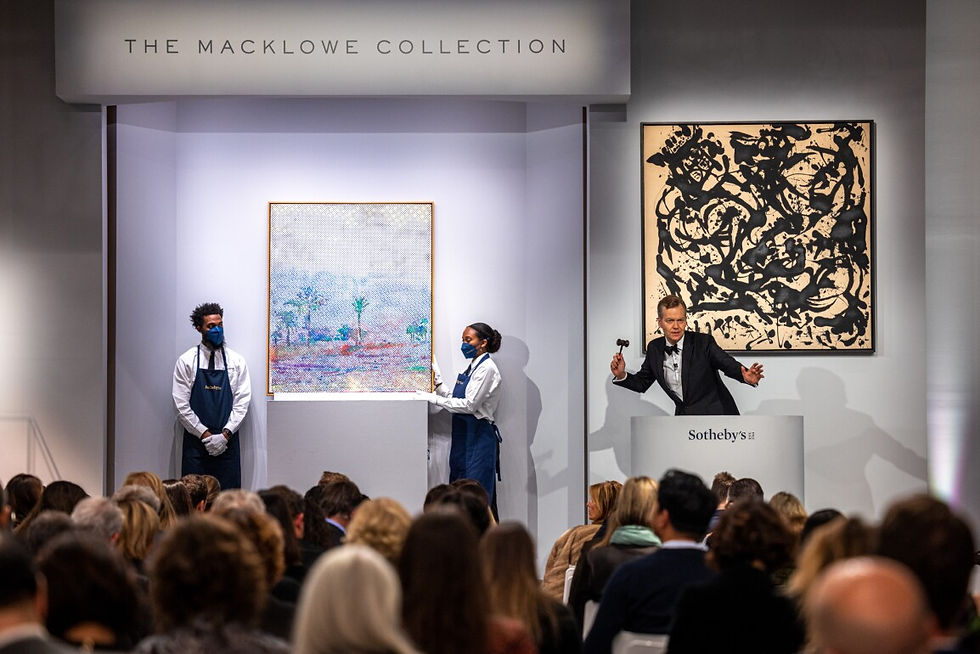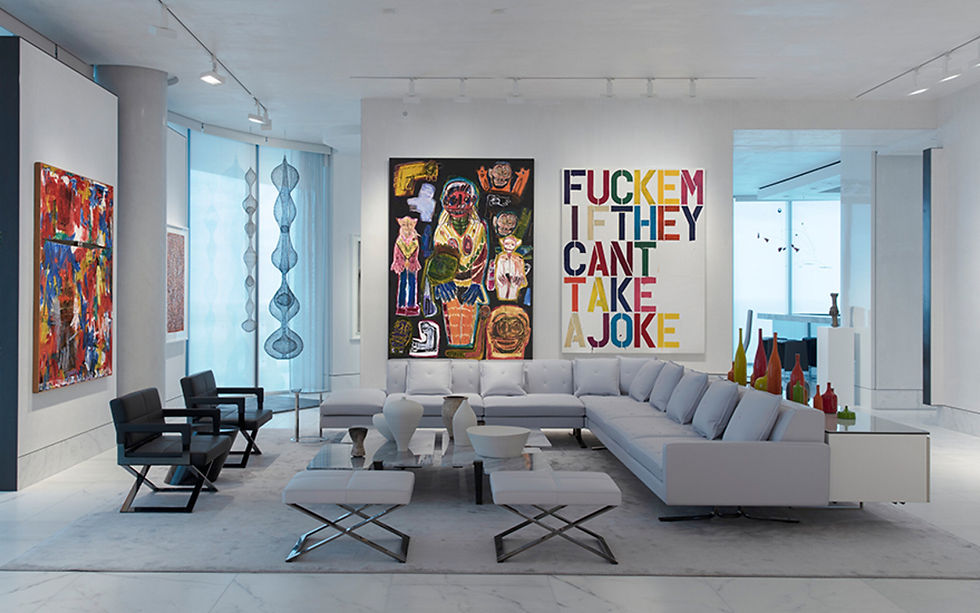What the first half of 2023 tells us about the state of the current art market
- Yoann Guez
- Sep 12, 2023
- 15 min read

The first half of 2023 has gone by, and we now have a clearer understanding of the factors at play behind the havoc that was witnessed during the most recent Spring auction sales. According to the latest Artnet/Art Intelligence report, the first five months of 2023 saw a -22% drop of global auctions turnover by Sotheby’s, Christie’s and Phillips compared to 2022. More specifically, a total of $ 5 billion was spent in the “fine art” category at auctions during this time span in 2023, which represents a 14% drop compared to 2022. From a geographical standpoint, of these $ 5 billion, 2.6 (more than half) were spent in the United States—a 25% drop compared to 2022—and China was the only one of the three major national markets to see its auction turnover increase in 2023. It should also be noted that the average price of an artwork sold at auction also dropped by 6% compared to 2022 (a figure to keep in mind as the present article unfolds). Upon analyzing the November 2022 auction sales in our previous article, we had seen that price corrections were mainly something that applied to ultra-contemporary artists, and that the general market was affected by a shortage of buyers. If the most recent May 2023 auctions sales tell us something, it is this: the demand crisis has deepened, and the price corrections now also apply to well-established blue chip artists of Modern & Contemporary art. But what is really going on that can explain the shortage of buyers, apart from the general consensus around the consequences felt from the lagging behind of the Chinese market? And what can explain that blue chip artists are now also subject to catastrophic price drops? As we will see, it seems that a shortage of supply on the high-end of the market is also playing an important part in the recent downturn.
Several factors impact demand, but two things are particularly paramount: access to liquidities—notably through loans or fiscal mechanisms—and the level of trust in the value of exchanged works of art. As regards loans, the level of leverage in the art world is relatively low but has been constantly growing in the last 15 years; but, as we will see, it mostly grew in the “high-end” of the market. In 2008, Art Capital Group estimated that American and international collectors alike had borrowed $ 2 to 3 billion in art-backed loans (using art as a collateral) according to an article published by Art Market Monitor that same year. The article mentions that there is no way to know for certain whether these loans are reinvested in art or not, and that, had it fully been the case, it would still only account for a small percentage (1.3 to 2%) of the global art turnover of the previous decade (from 1998 to 2008). In other words, in 2008, leverage in the art world was far from ubiquitous. An article from 2020 by Bloomberg entitled “Leverage is exploding in the Fine Art world” gives an account of the evolution of art-backed loans since then: this type of loans increased by 40% between 2016 and 2020, reaching $ 21 billion in 2020. This represents more than 8 folds the amount of 2008. Once more, according to Bloomberg, these liquidities end up serving various types of investments, such as real estate: the considerable growth of art-backed loans by no means equates the growth of leveraged investments in art.

But as Bloomberg details with the example of hedge fund manager Daniel Sundheim, the development of art-backed loans did enable some “top players” to leverage their collections in order to garner liquidities and acquire increasingly important works by blue chip artists. Sundheim, who clearly qualifies as a “top player” (he managed to become a board member of New York’s MoMA) started collecting art in 2010 and took out his loan at JP Morgan in 2013. In 2013, his collection was worth $ 30 million. In April 2020, Sundheim’s collection, collateralized in exchange for a loan at JP Morgan, was worth $ 300 million, and comprised some of the most expensive works by Cy Twombly and Andy Warhol at the time. Hence, by leveraging his art collection, he had multiplied its value 10 folds in 7 years. And as Bloomberg explains, although it might be difficult to have a clear vision of the proportions of art-backed loans reinvested in art, Sundheim is far from being an exception in the realm of top collectors. These players, who mostly come from capital intensive industries such as hedge-funds, private equity, tech, and big data, oftentimes built their companies with debt. They are hence no strangers to this way of managing their finances, and there is no reason for them to treat art collecting differently. According to Bloomberg, the most privileged of these collectors obtain loans amounting up to 50% of their collection’s worth and with interest rates as low as 1%; this helps them generate considerable amounts of working capital to continue investing in art, or elsewhere.

Let us now take a detour on fiscal matters in the US to get a better understanding of how various art market players—not only the “cream of the crop”—have found liquidities in recent years. In 2018, the Trump administration removed fine art from the assets included in the “like-kind exchanges” fiscal deferral (section 1031 of the IRC), which enabled investors to not have to pay capital income tax immediately after a sale (at the condition that the income be reinvested in a similar asset). According to the most recent Artnet News report, this fiscal deferral had made it possible for many American art market players (collectors and professionals alike) to garner the liquidities required to continue investing in art. There was hence a fear, when fine art was excluded from the list (making it less competitive in the short term than other investments), that the art market would undergo a crisis, and lobbyists tried their best—to no avail—to have it reinstated. But what happened was quite different: many art market players simply started to jump on the bandwagon of art-backed loans—a solution made all the more attractive by the fact that interest rates were at a historical low. So instead of selling artworks (and now paying the tax) as they would have been inclined to do before, collectors and professionals started to leverage their collections with art-backed loans and the practice became ubiquitous in recent years, although, as we just mentioned, it mainly favored “top players”. Bank of America (one of the major providers of art-backed loans) hence reports that its business witnessed a 250% growth of the amount of these loans in the last decade. But we are now in a time of high interest rates: the cost of debt has gone from around 2 to 7%. It is thus about 3 times more costly to borrow the same amount now than it used to be a year ago. And so, demand naturally decreases: collectors and professionals—those who don’t have some of the most expensive Twomblys or Warhols ever like Daniel Sundheim to leverage against competitive loans—are less prone to spend their money. They try to preserve their liquidities to acquire truly important pieces in the body of work of an artist; they don’t just buy a name anymore. In other words, Sundheim’s way of handling things—that is, trying to get increasingly valuable works in one’s collection—is becoming more and more prevalent among all the players that drive the art market. A great name does not suffice anymore: one has to have “the right work”, a truly remarkable trophy work. In short, buyers are increasingly skittish at the idea of acquiring “banal” work even by blue chip artist.
Seeing this dynamic at play, one might ask: is the status of contemporary art as a safe-haven investment endangered? To try to give an answer, let us have a look at the last major crisis in contemporary art in recent years: the burst of the Zombie Formalism bubble in 2016. It is interesting to notice that this art market crisis also occurred during a time of successive interest rate hikes by the Federal Reserve in the United States, which lasted around three years in this case. The art market took about three years as well to reach its previous level. Despite the impact of the burst, the art market went back to considerable growth from 2019 onwards, just as the Federal Reserve was once more severely lowering its interest rate, making loans more competitive and overall injecting liquidities in the general economy.

The evolution of interest rates thus seems to have a drastic impact on the accretion of value in the art market by making it easier for more market players to invest in art (see graphs below for a comparison of Federal Reserve prime rates and the Artprice100 index). We can notably see that the time periods of cuts in the Federal Reserve interest rate (2000-2004, 2008-2016, and 2020-2022) are concurrent with times of art market expansion. Nothing really surprising here: the cuts in prime rate are indeed directly intended to encourage banks and investors alike to spend their money in the general economy (times of negative prime rates as we have witnessed in recent years mean that banks would have to pay the FED or the ECB to put their money there), and therefore, indirectly, in art. Conversely, we are witnessing a paradigm change since 2022: government bonds enable a 6-7% return on investment, thus competing with demand for art as a safe-haven investment.

Lastly, we know—as we mentioned in our article about the November sales—that the globalization of the art market (and in particular the rise of Asia) has structurally impacted the overall growth of demand for contemporary art during the last 15 years. Which is why the return of China on the art market is long awaited. China’s internal market is currently showing signs of a progressive return to growth: as it turns out, it is the only one of the top three national markets to have better auction turnover numbers in the first 5 months of 2023 compared to those of 2022 (Artnet report). But these numbers can be quite deceiving, as the return of China’s internal market does not equate to the return of Chinese collectors on the international art scene. In fact, the opposite might be true, as money spent in China is not spent elsewhere and the internal market might still be boosted by restrictions preventing Chinese collectors from taking their money out of the country. Nothing indicates that the Chinese government is not aiming to progressively develop an internal market to which foreign investors and market players would have very limited access in the coming years. As it turns out, China’s Central Bank has just announced late August 2023 that it would lower its one-year-loan prime rate for the second time in the last three months—a measure that favors their internal market, as we have just seen above. A number that is more revealing of the presence of Chinese collectors on the international art market is the percentage of Chinese buyers at Western auction sales; and although these numbers for the latest spring auction season have not yet been made public, we have been told by insiders that they are unfortunately decreasing.

On top of that, there are negative signs on the institutional front of the Chinese art scene, as far as buying “foreign” art is concerned: the renowned Long Museum of Shanghai recently announced that it would sell about $ 150 million worth of artworks (pieces that were for the most part acquired in recent years) at Sotheby’s in the near future. It should also be said that Chinese collectors—who are fairly young themselves in comparison to the average European or American collector—are among the most exposed to some of the young hot commodities that took a hit at the recent May auction sales. A recent article on Artnet News hence recounted the story of Ding Yixiao, who withdrew his three lots from the scarce The Now sale at Sotheby’s London in June 2023 (which already comprised no more than 17 lots). The lots were three paintings by Louise Bonnet, Hilary Pecis and Emily Mae Smith—all young hot commodities of the ultra-contemporary art market in recent years. Born in 1994, the young and wealthy collector, who founded the Xiao Museum of Contemporary Art in Rizhao, in China’s Shandong province, had feared that the market was too “bad now” to sell. Last but not least, a lot of wealthy Chinese people are also very exposed to the current real estate crisis going on over there. All of this shows that we have yet to see a definite sign of the return of Chinese collectors on the international art scene. However, at the same time, the Asian markets players of tomorrow are emerging in Korea, Taiwan, and maybe even India in the near future. Indeed, as we have seen in our previous article, Seoul is amongst the most promising emerging markets for contemporary art, and Asia as a whole is rapidly gaining market shares. It might be too soon to say if Chinese collectors are about to make a comeback on the international art market, but the general trend in Asia seems to be that of continued growth that will bring more players to the international collector base.
Let us now turn to supply to complement our understanding of the dips that were witnessed during last spring’s auction sales. Underneath what one could assume is a “crisis of supply” lies a more complex reality: not unlike the sales of November 2022, the results of May 2023 are in part due to a lack of major works to raise the prices. Coincidentally with the lack of demand, sellers are also more skittish to put their prize artworks up for sale given the current context. For example, last year’s spring sales, works such as Shot Sage Blue Marilyn (1964) by Andy Warhol were hammered off for record prices ($ 195 million); this year, there was no such piece up for grabs to be found. Furthermore, according to Artelligence, the average price of a lot during the New York auction sales dipped from $ 1.8 million in May and November 2022 to $ 1 million in May 2023—a drop of nearly 45%. During the same time, according to the same report, the number of lots put up for sale at auction increased by 18% compared to 2022. But we also know auction houses have said to have had much difficulty to consign works of art last spring. All of this confirms that what auction houses in truth had difficulty finding was the so-called “trophy lots” of exceptional quality. We are not really witnessing a crisis of supply in the broad sense, but mostly on top-tier artworks of the highest price-bracket. This was in itself quite visible during the major evening sales, where one saw many artworks allowed entry into these top sales that would in previous years have not been works of choice…

It was also confirmed by the latest Artnet report, which observed a 51% decrease of global auction turnover in the price bracket of works over $ 10 million in the first five months of 2023 compared to the same five months in 2022. The same report also attests that other price brackets actually performed relatively well—in comparison to the high-end bracket, that is… as the dip in quality was largely ubiquitous during the latest auction season. The bracket of works with prices comprised between $ 1 and 10 million saw a 14% increase in auction turnover in the first five months of 2023 compared to those of 2022, and that of works with prices between $ 100,000 and 1 million grew by 18%. According to Artnet, the decrease on the highest price bracket is to be explained by the accumulation of high-end works during the covid crisis (sellers waiting for the right time to make a transaction). Right after the crisis, the art market thus witnessed a surge of exceptional pieces such as those of the Macklowe or Ammann collections; the top works of the first half of 2023 paled in comparison, which explains away much of the decrease witnessed (it should be noted that the Paul Allen collection, sold during Autumn 2022, is not even accounted for in the comparison).
But, as it happens, there is an ever more important impact of the presence of “trophy lots” at auctions—and more generally high-end works—on the art market as a whole. This is firstly true outside of auction sales: the amount of transactions by art dealers internationally grew by 7% from 2022 in comparison to 2021, but it mostly benefitted large scale galeries: “While the larger dealer segments grew, sales for the smallest dealers, and many parts of the auction market contracted,” according to Noah Horowitz, CEO of Art Basel. And the overall performance of the art market at auctions is more and more dependent on the performance at auctions of said lots. Indeed, the most important portion of global turnover at auctions in 2022 was that of artworks worth more than $ 10 million. It was also the only price bracket to have increased its global turnover at auctions in 2022 compared to 2021—justifying the fear that the art market is very dependent on the health of the market for high-end artworks. As Morgan Stanley puts it in its recent report for Artnet news: “Every year, fine artworks in the market’s uppermost price echelon have an outsized effect on the overall performance of fine art at auction. More specifically, the availability and performance of so-called trophy lots—works of fine art sold for more than $10 million each—have never been more important.” But the constant year-to-year increase of prices of “trophy lots” at auctions is itself reliant on price-guarantee mechanisms such as House guarantees, Third-party guarantees, and Enhanced hammers. As Morgan Stanley sums up: “The financialized nuances of the fine-art auction market impact the highest-priced lots more than any other sector of the market […]. This makes intuitive sense: the higher the stakes, the more inclined sellers and auction houses alike may be to limit their downside risk using the tools available.” It is thus quite logical that once these mechanisms vanish, the price hikes on artworks at the high-end of auction sales are at risk, which is precisely what we witnessed during the auction sales of last May. The most notable case was the sale of the Gerald Fineberg collection at Sotheby’s. The Fineberg estate had negotiated the best possible deal with Sotheby’s while refusing third-party price guarantees for their lots. In a favorable economic context prone to encourage record-high bids on exceptional lots, this would most likely have been a smart decision for the estate to maximize its gains. But, as we now know, it didn’t go too well… The absence of third-party guarantees had removed from the auction the market players who wish to guarantee a price on a lot on the off chance that the final bid exceeded their guaranteed price (thus enabling them to profit off of an artwork they don’t even need to acquire) in an art market where there was already a shortage of demand. In the face of the absence of price guarantees and the current economic context from which price drops could ensue, bidders became especially risk-averse and the whole sale was impacted.

In short, what was witnessed was the true face of the art market without the institutional “crutches” designed to maintain high prices. Without price guarantees, the crisis of supply deepens as sellers are more and more wary of putting their prized “trophy lots” on sale. But these guarantees themselves rely on the overall trust in the growth of the art market. Consequently, the art market is now faced with a conjunction of negative factors which mutually reinforce each other: a shortage of supply on the front of the high-end “trophy lots” which drastically impacts the overall health of the art market, and a general lack of trust in the art market since November 2022 which makes it more difficult than ever to find third parties interested in providing important price guarantees for these lots. In turn, this makes it even more difficult for auction houses to consign exceptional lots (as sellers still want those price guarantees, especially given the current context). Ironically, as Morgan Stanley notes in its article for Artnet news, auction houses are now kind of trapped within this dynamic (that otherwise makes their riches in times of growth). Indeed, the competition to garner and consign the best “trophy lots” which define auction turnovers is all the rage, and the auction house which has the most price guarantees wins this battle. But, as Morgan Stanley concludes: “by ensuring that trophy lots continue to sell for tens, if not hundreds, of millions of dollars through such financialization, the houses arguably put pressure on themselves to repeat the process with the next wave of major auctions.” The problem with such a loop is that, once a bad auction season arises and the overall level of trust diminishes, a vicious circle emerges : sellers are made wary of the market, buyers are made cautious even towards unexceptional works by blue chip artists, and the auction houses pay the price of having to cater to consignors.
Art constitutes an investment which depends on a wide array of factors related to the rest of the general economy (interest rates, investment arbitrations, etc.). The globalization of the art market these last ten years has brought forth structural factors, such as the expansion of the worldwide collector base. This has an undeniably positive impact on the development of the art market—and in particular of the contemporary art segment—in the long term. However, in the current context, we are forced to recognize that certain elements acting in favor of a general hike in prices have hit a wall. To break the curse, one can hope that external factors (such as the effective return of Asian collectors on the international art market or the evolution of Federal Reserve and ECB interest rates) will eventually revive overall trust in the market for all stakeholders. As of now, the market uncertainty affecting even the “blue chip” segment is the infallible sign of a paradigm change: the auction sales mechanisms which used to give a bulletproof vest to high-end prices are now endangered by the current timidity of art market players.

But as the Artnet/Art Intelligence report cleverly reminds us, a market with important price corrections is a market of opportunities: it might be the right time to collect some of the best established artists impacted by the drops, in the same way a few great past collections were built in times of crisis. The current context might be frightening in some regards, but let us not forget that the most impressive downfalls have come from the young hot commodities of ultra-contemporary art. A smart collector with an acute sense of aesthetic values can make the most of it: “welcome to the buyer’s market”, as Artnet puts it.

Comments